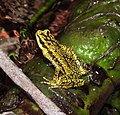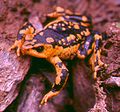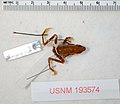| Image | Common name | Binomial name | Conservation status |
|---|
|
| Andes stubfoot toad | Atelopus andinus Rivero, 1968 | EN IUCN |
| Angelito stubfoot toad | Atelopus angelito Ardila-Robayo and Ruiz-Carranza, 1998 | CR IUCN (possibly extinct) |
| Ardila's stubfoot toad | Atelopus ardila Coloma, Duellman, Almendariz, Ron, Teran-Valdez, and Guayasamin, 2010 | CR IUCN (possibly extinct) |
 | Starry night harlequin toad | Atelopus arsyecue Rueda-Almonacid, 1994 | CR IUCN |
 | Arthur's stubfoot toad | Atelopus arthuri Peters, 1973 | CR IUCN |
 | Rio Pescado stubfoot toad | Atelopus balios Peters, 1973 | CR IUCN |
 | Purple harlequin toad | Atelopus barbotini Lescure, 1981 | LC IUCN |
| Azuay stubfoot toad | Atelopus bomolochos Peters, 1973 | CR IUCN |
| Boulenger's stubfoot toad | Atelopus boulengeri Peracca, 1904 | CR IUCN |
| | Atelopus calima Velásquez Trujillo, Castro Herrera, Lötters & Plewnia, 2024 | |
| Rio Carauta stubfoot toad | Atelopus carauta Ruiz-Carranza & Hernández-Camacho, 1978 | DD IUCN |
 | Venezuelan yellow frog or La Carbonera stubfoot toad | Atelopus carbonerensis Rivero, 1974 | CR IUCN |
 | Guajira stubfoot toad | Atelopus carrikeri Ruthven, 1916 | EN IUCN |
 | Darien stubfoot toad or Toad Mountain harlequin frog | Atelopus certus Barbour, 1923 | CR IUCN |
 | Chiriqui harlequin frog | † Atelopus chiriquiensis Shreve, 1936 | EX IUCN |
| | Atelopus chirripoensis Savage and Bolaños, 2009 | DD IUCN |
| Chocó stubfoot toad | Atelopus chocoensis Lötters, 1992 | CR IUCN (possibly extinct) |
| | Atelopus chrysocorallus La Marca, 1996 | CR IUCN |
| | Atelopus colomai Plewnia, Terán-Valdez, Culebras, Boistel, Paluh, Quezada Riera, Heine, Reyes-Puig, Salazar-Valenzuela, Guayasamin & Lötters, 2024 | |
 | Rio Faisanes stubfoot toad | Atelopus coynei Miyata, 1980 | CR IUCN |
 | Veragua stubfoot toad | Atelopus cruciger (Lichtenstein & Martens, 1856) | CR IUCN |
| | Atelopus dimorphus Lötters, 2003 | DD IUCN |
| Huila stubfoot toad | Atelopus ebenoides Rivero, 1963 (possibly extinct) | CR IUCN (possibly extinct) |
 | Elegant stubfoot toad | Atelopus elegans (Boulenger, 1882) | EN IUCN |
| Peruvian harlequin frog | Atelopus epikeisthos Lötters, Schulte & Duellman, 2005 | EN IUCN |
| Carabaya stubfoot toad | Atelopus erythropus Boulenger, 1903 | CR IUCN (possibly extinct) |
| Malvasa stubfoot toad | Atelopus eusebianus Rivero & Granados-Díaz, 1993 | CR IUCN (possibly extinct) |
| | Atelopus eusebiodiazi Venegas, Catenazzi, Siu-Ting & Carrillo, 2008 | CR IUCN (possibly extinct) |
| Mazán jambato frog | Atelopus exiguus Boettger, 1892 | EN IUCN |
| | Atelopus famelicus Rivero & Morales, 1995 | CR IUCN |
| Forest stubfoot toad | Atelopus farci Lynch, 1993 | CR IUCN (possibly extinct) |
| | Cayenne stubfoot toad | Atelopus flavescens Duméril & Bibron, 1841 | VU IUCN |
| | Central Coast stubfoot toad | Atelopus franciscus Lescure, 1974 | LC IUCN |
| Border harlequin frog | Atelopus frontizero Veselý & Batista, 2021 | |
| Antado stubfoot toad | Atelopus galactogaster Rivero & Serna, 1993 | DD IUCN |
| Giant stubfoot toad | Atelopus gigas Coloma, Duellman, Almendáriz, Ron, Terán-Valdez, and Guayasamin, 2010 | CR IUCN (possibly extinct) |
 | Pirri Range harlequin frog | Atelopus glyphus Dunn, 1931 | CR IUCN |
 | Guanujo stubfoot toad | Atelopus guanujo Coloma, 2002 | CR IUCN (possibly extinct) |
| La Guitarra stubfoot toad | Atelopus guitarraensis Osorno-Muñoz, Ardila-Robayo & Ruiz-Carranza, 2001 | DD IUCN |
| Morona-Santiago stubfoot toad | Atelopus halihelos Peters, 1973 | CR IUCN (possibly extinct) |
| |
| | Atelopus harlequin Coloma, Plewnia, Böning, Boistel, Ellwein, Lötters, Paluh, Roca-Rey Ross & Venegas, 2025 | |
| | Atelopus histrionicus Lötters, Plewnia, Böning, Boistel, Chaparro, Coloma, Ellwein, Orsen, Paluh & Venegas, 2025 | |
 | Hoogmoed harlequin toad | Atelopus hoogmoedi Lescure, 1974 | |
 | Quito stubfoot toad | Atelopus ignescens (Cornalia, 1849) | CR IUCN |
 | San Lorenzo stubfoot toad | Atelopus laetissimus Ruiz-Carranza, Ardila-Robayo & Hernández-Camacho, 1994 | EN IUCN |
 | Limosa harlequin frog | Atelopus limosus Ibáñez, Jaramillo & Solís, 1995 | CR IUCN |
| | Atelopus loettersi De la Riva, Castroviejo-Fisher, Chaparro, Boistel, and Padial, 2011 | NT IUCN |
| El Tambo stubfoot toad | Atelopus longibrachius Rivero, 1963 | EN IUCN |
 | Longnose stubfoot toad | Atelopus longirostris Cope, 1868 | CR IUCN |
| | Atelopus lozanoi Osorno-Muñoz, Ardila-Robayo & Ruiz-Carranza, 2001 (endangered) | EN IUCN |
| Lynch's stubfoot toad | Atelopus lynchi Cannatella, 1981 | CR IUCN (possibly extinct) |
| Manaus harlequin frog | Atelopus manauensis Jorge, Ferrão & Lima, 2020 | |
| | Atelopus mandingues Osorno-Muñoz, Ardila-Robayo & Ruiz-Carranza, 2001 | DD IUCN |
| | Atelopus marinkellei Cochran and Goin, 1970 | EN IUCN |
| Mindo stubfoot toad | Atelopus mindoensis Peters, 1973 | CR IUCN |
| Colombian stubfoot toad | Atelopus minutulus Ruiz-Carranza, Hernández-Camacho & Ardila-Robayo, 1988 | CR IUCN (possibly extinct) |
| Mittermeier's stubfoot toad | Atelopus mittermeieri Acosta-Galvis, Rueda-Almonacid, Velásquez-Álvarez, Sánchez-Pacheco & Peña Prieto, 2006 | EN IUCN |
| Hernandez's stubfoot toad | Atelopus monohernandezii Ardila-Robayo, Osorno-Muñoz & Ruiz-Carranza, 2002 | CR IUCN (possibly extinct) |
| | Atelopus moropukaqumir Herrera-Alva, Díaz, Castillo, Rodolfo & Catenazzi, 2020 | |
 | Mucubaji stubfoot toad | Atelopus mucubajiensis Rivero, 1974 | CR IUCN |
| La Arboleda stubfoot toad | Atelopus muisca Rueda-Almonacid & Hoyos, 1992 | CR IUCN |
 | | Atelopus nahumae Ruiz-Carranza, Ardila-Robayo & Hernández-Camacho, 1994 | EN IUCN |
| Sad harlequin frog | Atelopus nanay Coloma, 2002 | CR IUCN |
| Gualecenita stubfoot toad | Atelopus nepiozomus Peters, 1973 | EN IUCN |
| Niceforo's stubfoot toad | Atelopus nicefori Rivero, 1963 | CR IUCN (possibly extinct) |
| Nocturnal harlequin toad | Atelopus nocturnus Bravo-Valencia and Rivera-Correa, 2011 | CR IUCN |
| | Atelopus onorei Coloma, Lötters, Duellman & Miranda-Leiva, 2007 | CR IUCN (possibly extinct) |
| | Atelopus orcesi Coloma, Duellman, Almendáriz, Ron, Terán-Valdez & Guayasamin, 2010 | CR IUCN (possibly extinct) |
| | Atelopus oxapampae Lehr, Lötters, and Lundberg, 2008 | EN IUCN |
| Rednose stubfoot toad | Atelopus oxyrhynchus Boulenger, 1903 | CR IUCN (possibly extinct) |
| Schmidt's stubfoot toad | Atelopus pachydermus (Schmidt, 1857) | CR IUCN (possibly extinct) |
 | Andersson's stubfoot toad | Atelopus palmatus Andersson, 1945 | CR IUCN |
| Pastuso harlequin frog | Atelopus pastuso Andersson, 1945 | CR IUCN (possibly extinct) |
 | Pataz stubfoot toad | Atelopus patazensis Venegas, Catenazzi, Siu-Ting & Carrillo, 2008 | CR IUCN |
| San Isidro stubfoot toad | Atelopus pedimarmoratus Rivero, 1963 | CR IUCN (possibly extinct) |
| Peru stubfoot toad | Atelopus peruensis Gray & Cannatella, 1985 | CR IUCN (possibly extinct) |
 | Peters' stubfoot toad | Atelopus petersi Coloma, Lötters, Duellman & Miranda-Leiva, 2007 | CR IUCN (possibly extinct) |
| Painted stubfoot toad | Atelopus petriruizi Ardila-Robayo, 1999 | CR IUCN (possibly extinct) |
| | Atelopus pictiventris Kattan, 1986 | CR IUCN (possibly extinct) |
| Pinango stubfoot toad | Atelopus pinangoi Rivero, 1982 | CR IUCN (possibly extinct) |
| Napo stubfoot toad | Atelopus planispina Jiménez de la Espada, 1875 | CR IUCN (possibly extinct) |
| Podocarpus stubfoot toad | Atelopus podocarpus Coloma, Duellman, Almendáriz, Ron, Terán-Valdez, and Guayasamin, 2010 | CR IUCN |
 | Río Huallaga stubfoot toad | Atelopus pulcher Boulenger, 1882 | VU IUCN |
| | Atelopus pyrodactylus Venegas & Barrio, 2006 | CR IUCN |
| Quimbaya toad | Atelopus quimbaya Ruiz-Carranza & Osorno-Muñoz, 1994 | CR IUCN (possibly extinct) |
| | Atelopus reticulatus Lötters, Haas, Schick & Böhme, 2002 | DD IUCN |
| Anori stubfoot toad | Atelopus sanjosei Rivero & Serna, 1989 | CR IUCN |
| Upper Amazon stubfoot toad | Atelopus seminiferus Cope, 1874 | EN IUCN |
| Pass stubfoot toad | † Atelopus senex Taylor, 1952 | EX IUCN |
| Baldias harlequin toad | Atelopus sernai Ruiz-Carranza & Osorno-Muñoz, 1994 | CR IUCN (possibly extinct) |
| Camouflaged harlequin toad | Atelopus simulatus Ruiz-Carranza & Osorno-Muñoz, 1994 | CR IUCN (possibly extinct) |
| | Atelopus siranus Lötters &Henzl, 2000 | DD IUCN |
| Sonsón stubfoot toad | Atelopus sonsonensis Vélez-Rodriguez & Ruiz-Carranza, 1997 | CR IUCN (possibly extinct) |
| Cloud forest stubfoot toad | Atelopus sorianoi La Marca, 1983 | CR IUCN (possibly extinct) |
 | Pebas stubfoot toad | Atelopus spumarius Cope, 1871 | VU IUCN |
 | Condoto stubfoot toad | Atelopus spurrelli Boulenger, 1914 | NT IUCN |
| Bogota stubfoot toad | Atelopus subornatus Werner, 1899 | CR IUCN |
 | Venezuela stubfoot toad | Atelopus tamaensis La Marca, García-Pérez & Renjifo, 1990 | CR IUCN |
 | Three-colored stubfoot toad | Atelopus tricolor Boulenger, 1902 | CR IUCN |
 | Veragoa stubfoot toad | Atelopus varius (Lichtenstein & Martens, 1856) | CR IUCN |
| Maracay harlequin frog | † Atelopus vogli Müller, 1934 | EX IUCN |
| Walker's stubfoot toad | Atelopus walkeri Rivero, 1963 | DD IUCN |
 | Panamanian golden frog | Atelopus zeteki Dunn, 1933 | CR IUCN (possibly extinct in the wild) |
|
































